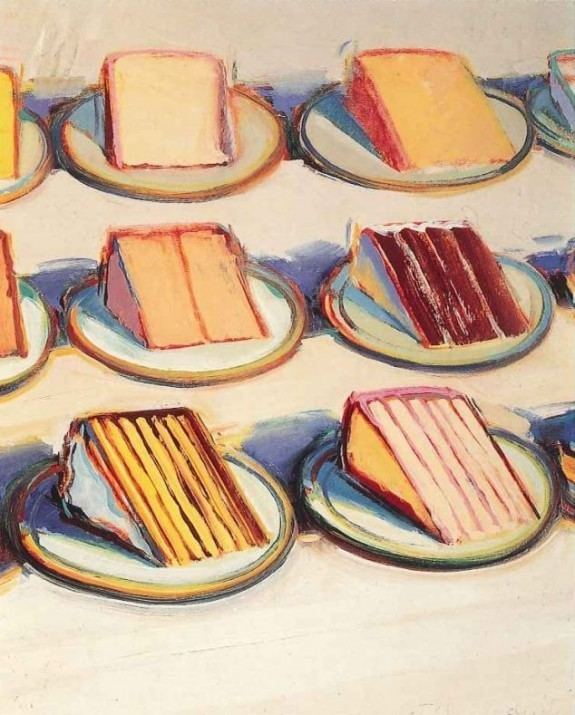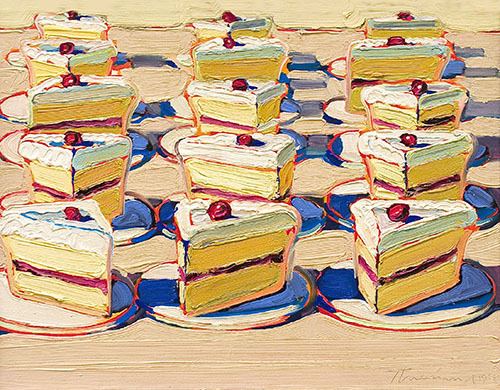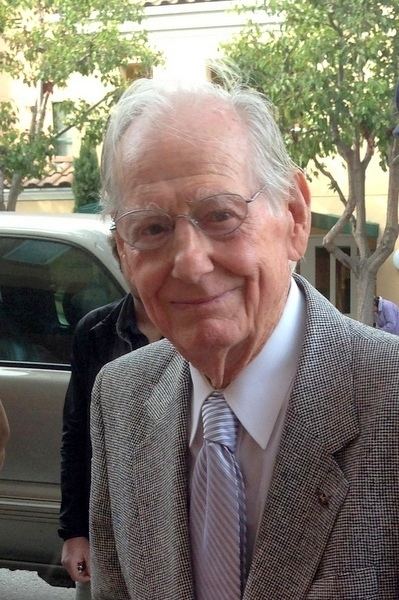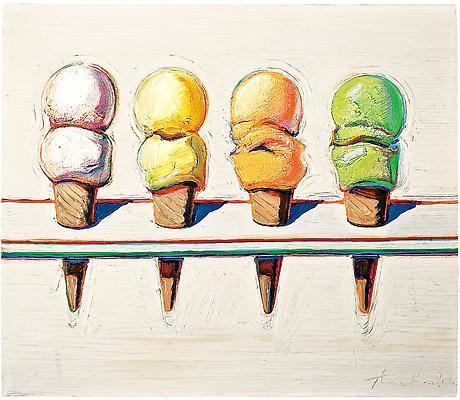Awards National Medal of Arts Nationality American | Role Artist Name Wayne Thiebaud | |
 | ||
Books Wayne Thiebaud, Wayne Thiebaudprivate drawings Similar People | ||
Wayne thiebaud beyond the cakes
Wayne Thiebaud (born November 15, 1920) is an American painter widely known for his colorful works depicting commonplace objects—pies, lipsticks, paint cans, ice cream cones, pastries, and hot dogs—as well as for his landscapes and figure paintings. Thiebaud is associated with the pop art movement because of his interest in objects of mass culture, although his early works, executed during the fifties and sixties, slightly predate the works of the classic pop artists. Thiebaud uses heavy pigment and exaggerated colors to depict his subjects, and the well-defined shadows characteristic of advertisements are almost always included in his work.
Contents
- Wayne thiebaud beyond the cakes
- Wayne thiebaud painted worlds the burt and deedee mcmurtry lecture
- Early life and education
- Early career
- Work
- Collections
- Recognition
- Influences
- References

Wayne thiebaud painted worlds the burt and deedee mcmurtry lecture
Early life and education

Thiebaud was born to Mormon parents in Mesa, Arizona, United States. His family moved to Long Beach, California when he was six months old. One summer during his high school years he apprenticed at Walt Disney Studios drawing "in-betweens" of Goofy, Pinocchio, and Jiminy Cricket at a rate of $14 a week. The next summer he studied at the Frank Wiggins Trade School in Los Angeles. From 1938 to 1949, he worked as a cartoonist and designer in California and New York. He served as an artist in the First Motion Picture Unit of the United States Army Air Forces from 1942 to 1945.

In 1949, he enrolled at San Jose State College (now San Jose State University) before transferring to Sacramento State College (now California State University, Sacramento), where he earned a bachelor's degree in 1951 and a master's degree in 1952.
Early career

Thiebaud subsequently began teaching at Sacramento City College. In 1960, he became assistant professor at the University of California, Davis, where he remained through 1991 and influenced numerous art students. He continues to hold a Professor Emeritus title there. Thiebaud did not have much of a following among Conceptual artists because of his adherence to basically traditional disciplines, emphasis on hard work as a supplement to creativity, and love of realism. Occasionally, he gave pro bono lectures at U.C. Davis.

On a leave of absence during 1956–57, he spent time in New York City, where he became friends with Elaine and Willem de Kooning and Franz Kline, and was much influenced by these abstractionists as well as by proto-pop artists Robert Rauschenberg and Jasper Johns. During this time, he began a series of very small paintings based on images of food displayed in windows, and he focused on their basic shapes.
Returning to California, he pursued this subject matter and style, isolating triangles, circles, squares, etc. He also co-founded the Artists Cooperative gallery, now Artists Contemporary Gallery, and other cooperatives including Pond Farm, having been exposed to the concept of cooperatives in New York.
In 1960, he had his first solo show in San Francisco at the San Francisco Museum of Modern Art, and shows in New York City at the Staempfli and Tanager galleries. These shows received little notice, but two years later, a 1962 Sidney Janis Gallery exhibition in New York officially launched Pop Art, bringing Thiebaud national recognition, although he disclaimed being anything other than a painter of illusionistic form.
In 1961, Thiebaud met and became friends with art dealer Allan Stone (1932–2006), the man who gave him his first "break." Stone was Thiebaud's dealer until Stone's death in 2006. Stone said of Thiebaud "I have had the pleasure of friendship with a complex and talented man, a terrific teacher and cook, the best raconteur in the west with a spin serve, and a great painter whose magical touch is exceeded only by his genuine modesty and humility. Thiebaud's dedication to painting and his pursuit of excellence inspire all who are lucky enough to come in contact with him. He is a very special man." After Stone's death, Thiebaud's son Paul Thiebaud (1960–2010) took over as his dealer. Paul Thiebaud was a successful art dealer in his own right and had eponymous galleries in Manhattan and San Francisco; he died June 19, 2010.
In 1962, Thiebaud's work was included, along with Roy Lichtenstein, Andy Warhol, Jim Dine, Phillip Hefferton, Joe Goode, Edward Ruscha, and Robert Dowd, in the historically important and ground-breaking "New Painting of Common Objects," curated by Walter Hopps at the Pasadena Art Museum (now the Norton Simon Museum of Art at Pasadena). This exhibition is historically considered one of the first Pop Art exhibitions in America. These painters were part of a new movement, in a time of social unrest, which shocked America and the art world.
In 1963, he turned increasingly to figure painting: wooden and rigid, with each detail sharply emphasized. In 1964, he made his first prints at Crown Point Press, and has continued to make prints throughout his career. In 1967, his work was shown at the Biennale Internationale.
Wayne Thiebaud has been married twice. With his first wife, Patricia Patterson, he produced two children, one of whom is the model and writer Twinka Thiebaud. With his second wife, Betty Jean Carr, he had a son, Paul LeBaron Thiebaud, who became an art dealer. He also adopted Betty's son, Matthew.
Work
Thiebaud is well known for his paintings of production line objects found in diners and cafeterias, such as pies and pastries. As a young man in Long Beach, he worked at a cafe named Mile High and Red Hot, where "Mile High" was ice cream and "Red Hot" was a hot dog.
He was associated with the Pop art painters because of his interest in objects of mass culture; however, his works, executed during the fifties and sixties, slightly predate the works of the classic pop artists, suggesting that Thiebaud may have had an influence on the movement. Thiebaud uses heavy pigment and exaggerated colors to depict his subjects, and the well-defined shadows characteristic of advertisements are almost always included in his work. Thiebaud is averse to labels such as "fine art" versus "commercial art" and has described himself as "just an old-fashioned painter". He dislikes Andy Warhol's "flat" and "mechanical" paintings and does not count himself as a pop artist.
In addition to pastries, Thiebaud has painted characters such as Mickey Mouse as well as landscapes, streetscapes, and cityscapes, which were influenced by the work of Richard Diebenkorn. His paintings such as Sunset Streets (1985) and Flatland River (1997) are noted for their hyper realism, and have been compared to Edward Hopper's work, another artist who was fascinated with mundane scenes from everyday American life.
Thiebaud is a voracious reader and is known for reading poetry to his students. Among his pupils was the painter Faith Bromberg.
Collections
Thiebaud’s works are also in permanent collections at the Los Angeles County Museum of Art; the Whitney Museum of American Art, New York; the Hirshhorn Museum and Sculpture Garden, Washington D.C.; the Smithsonian American Art Museum, Washington, D.C.; Albright-Knox Art Gallery, Buffalo, New York; San Francisco Museum of Modern Art; Crocker Art Museum, Sacramento; Phoenix Art Museum. Nelson-Atkins Art Museum, Kansas City, Missouri; and many other institutions.
Recognition
On October 14, 1994, Thiebaud was presented with the National Medal of Arts by President Clinton. He also received the Lifetime Achievement Award for Art from the American Academy of Design in 2001. Thiebaud was inducted into the California Hall of Fame in 2010 at the California Museum, Sacramento, and in 2013, he was honored with the California Art Award in recognition of his part in raising the prominence of California art around the world.
Influences
One of Thiebaud's students from Sacramento City College was the artist Fritz Scholder (1937–2005), who went on to become a major influence in the direction of American Indian art through his instruction at the Institute of American Indian Arts in Santa Fe, New Mexico (1964–1969). Mel Ramos, a painter and retired professor of art at California State University, East Bay, considers Thiebaud to be his mentor. Sharon Core is a photographer known for her photographic interpretations of Thiebaud's works.
